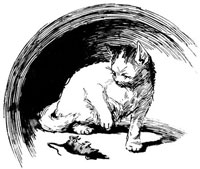|
 Cool Reception: Cats most likely came to Europe along trader ships coming from Egypt. In ancient Egypt cats had been revered, even worshipped. But in Europe, especially during the Middle Ages, their reputation was less glamorous. Here they were often mistrusted, even feared. Cool Reception: Cats most likely came to Europe along trader ships coming from Egypt. In ancient Egypt cats had been revered, even worshipped. But in Europe, especially during the Middle Ages, their reputation was less glamorous. Here they were often mistrusted, even feared.
The Midnight Hour: It may have been their nocturnal habits, or their association with sexuality (Even in Shakespeare’s Mac beth one the 3 witches, or weird sisters, is named Grimalkin, which can mean either gray cat or promiscuous woman), but cats became associated with the devil during the Middle Ages in significant parts of Europe. Those who owned cats were sometimes accused of being witches and burned alive. There are even instances of cats being tried before judges, then were tortured
and killed. Some believed it was good luck to bury live cats inside the walls of new buildings.
Rat-attack: As the cat population began to diminish, the rodent population began to rise. It is reasonable to believe that the prejudice against cats allowed, at least to some degree, the rise of disease, and some of the horrible plagues that struck the continent during the Middle Ages. Obviously sanitation and medicine were the primary factors, but cats had long assisted in controlling rat and rodent population, which are now known to be the primary carriers of certain diseases.
 People began seeing the cats as important, and even essential, so the prejudice People began seeing the cats as important, and even essential, so the prejudice
against them began to subside. Important and well-known figures made it acceptable,
and even fashionable, to own cats. Cardinal Richelieu, one of the most important and powerful men in all of Europe, loved cats
and owned many until his death in 1642.
He even had a cattery built in Versailles to house them all. Nearly everyone in France started taking cats
into their home, and
soon they became associated with refinement and sophistication.
|
